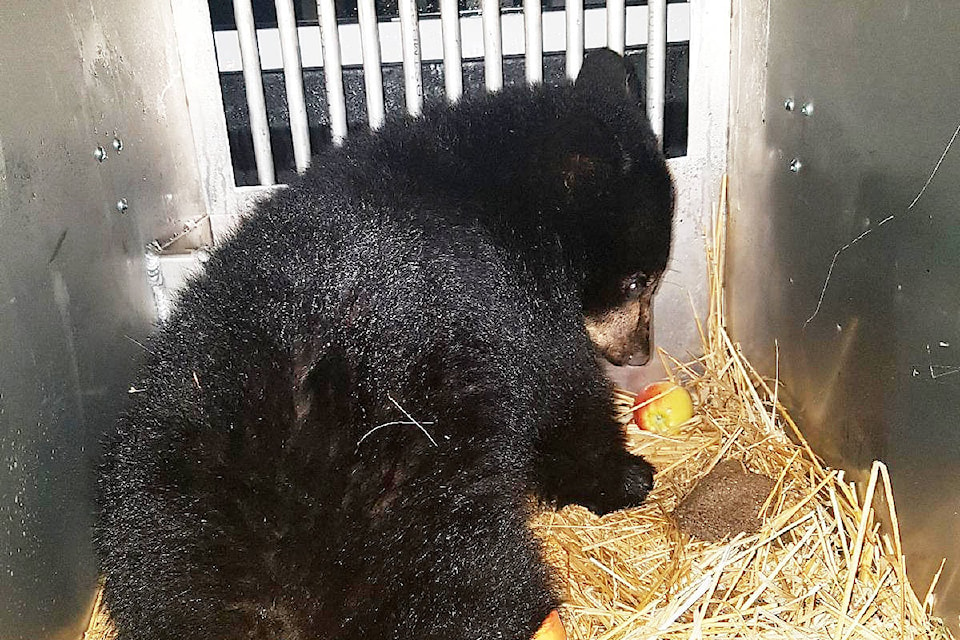An orphaned and underweight black bear cub was rescued off a property near Mahood Lake late in the evening on Thanksgiving Monday.
Angelika Langen of the Northern Lights Wildlife Society said the cub had been observed on her own for two weeks and at only 35 to 40 lbs, she would not have survived hibernation by herself.
“I don’t see any injuries. She got into some chicken starter there and that stuff is medicated, which is not really good for them.”
Langen said the cub was lethargic and showed slow reaction time.
She was able to tranquilize the cub and transfer her to the transport box beside an injured cub that was rescued in Williams Lake on Sunday. Both cubs will be rehabilitated and then hibernate at the facility in Smithers.
Volunteers will release the bears in June of 2019, when they would have naturally left their mothers. Langen said everything they do is run through the Conservation Officer Service for approval. So when the Mahood Lake area resident contacted the society directly, they were advised to make an official report.
Conservation officers reviewed the situation and agreed that the cub was a candidate for rehab.
Only after it’s been determined that the cub was born this year, has been orphaned and can’t survive the winter alone (either because it’s injured or underweight) can the society go in to rescue it.
If, however, the cub has already become habituated to human food sources, like garbage or bird feeders or fruit trees, they are no longer a candidate for rehabilitation and must be put down.
“Especially this time of year, if they have already been taught by the mother where they find this kind of food they will be really likely to re-offend,” said Langen.
“Then we’re going through all this and then we’re putting them out just to create a problem there. That’s really not helpful.”
The orphaned cub that was put down after it was spotted in a tree near 100 Mile Elementary, for example, did not qualify for relocation or rehabilitation.
James Zucchelli, of the 100 Mile House Conservation Officer Service, said there were several reported incidents of that cub coming in close proximity of people and feeding on garbage, compost, bird feeders, barbecues, etc.
“It basically has no idea which way is up and which way to go, so it’s just a matter of time before it’s going to cause problems or it’s going to starve to death here in the fall and in the winter.”
Zucchelli said it’s an “unfortunate circumstance” that conservation officers are put in when people are irresponsible with their attractants and bears become conditioned to non-natural food sources.
Especially this time of year, “no amount of rehabilitation is going to be effective,” when bears grow accustomed to human food sources, he said.
“So you’re just prolonging the death of the bears.”
Doing what feels good to us humans, he said, is often not the best thing for the animal’s welfare and he called it “a lose-lose situation” when people attract bears onto their properties.
Langen mirrored Zucchelli’s sentiments, saying it’s “the easy way out” to blame a conservation officer for putting a bear down when it’s often due to the complacency of a resident not clearing his or her attractants.
“I really don’t feel that we should become a feel-good solution for people.”
Rehabilitation is for “minimizing our footsteps in those cases where accidents occur,” like accidents with vehicles or accidental hunting shootings, said Langen, and not to get bears out of people’s garbages.
She said the majority of cases, when bears are put down after getting into garbages, can be prevented if people take more care to clear their attractants.
The two bears rescued from Williams Lake and Mahood Lake are numbers 20 and 21 for the society so far this year, according to Langen.
The society’s facility is not open to the public. Each bear receives its own caretaker during rehabilitation, which serves as its mother figure. They are taught to hide from other people so that they do not become accustomed to humans and can be safely released without risk of conflict.
She said they track the bears using collars, tags or chips and, from what they can tell, the bears are successful once they are released back into the wild.
